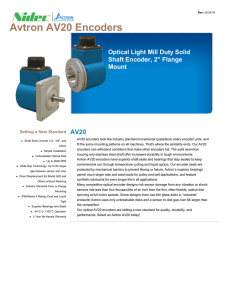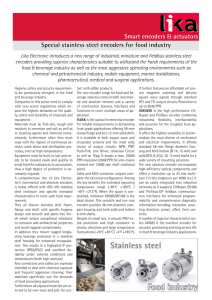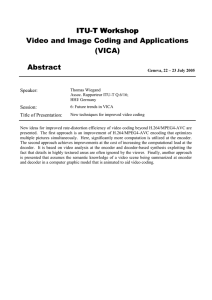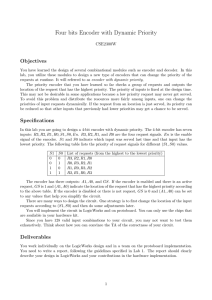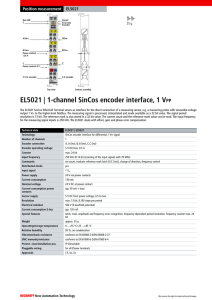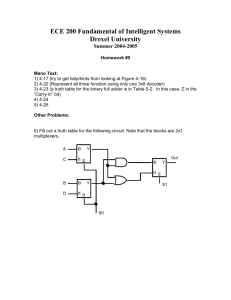General Wiring and Installation Guidelines
advertisement
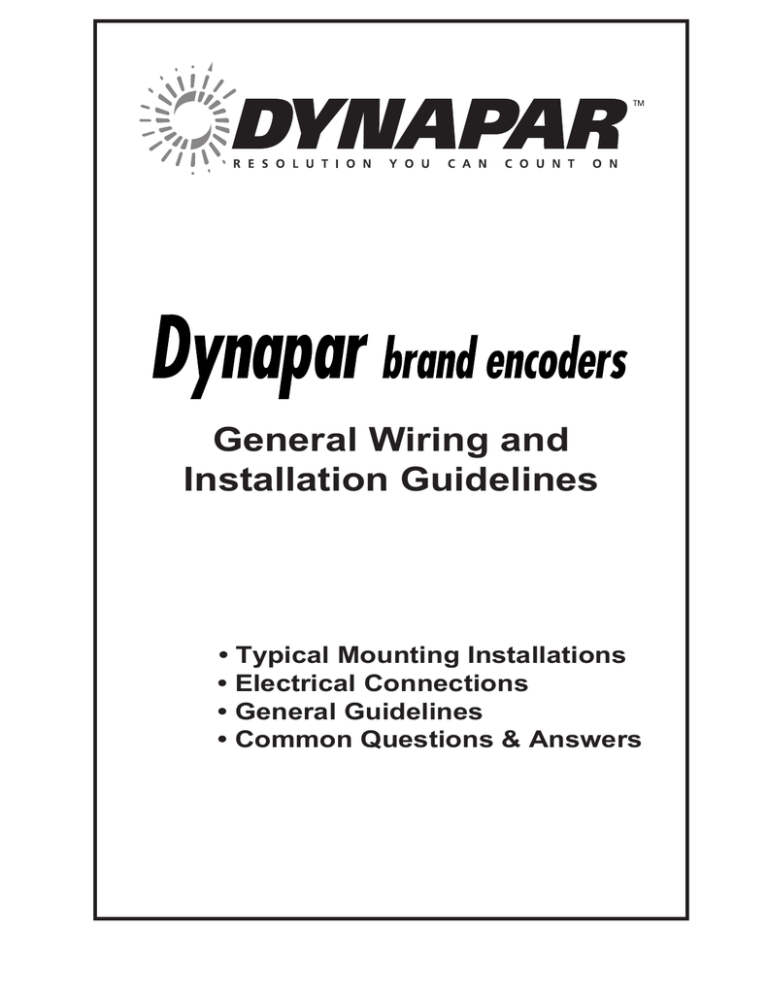
General Wiring and
Installation Guidelines
• Typical Mounting Installations
• Electrical Connections
• General Guidelines
• Common Questions & Answers
Congratulations on your purchase of a Dynapar brand
encoder. All Dynapar brand encoders are 100% final
tested and have a full one-year warranty against defects
in material and workmanship. This booklet is provided to
you as a guideline for the installation of your new encoder.
TYPICAL MOUNTING INSTALLATIONS
Dynapar brand encoders feature industry standard
mounting configurations and mounting bracket accessories to help simplify installation.
Shaft Encoders
Shaft encoders are typically
servo, flange, face, or foot
mounted.
MOUNTING CLIPS (3)
PANEL
SERVO MOUNT
FACE MOUNT
FOOT MOUNT
FLANGE MOUNT
Because shaft encoders have no flexture, mechanically
coupling one to a machine requires important consideration. Backlash or modulation in the coupling can cause
errors in position indication. Rigid attachment of the shaft
may cause bearing failure. Therefore, a flexible coupling, which compensates for misalignment between
the encoder shaft and the machine, must be used.
1
Flexible Couplings - Encoder shafts and bearings are
designed to require very restricted axial and radial play.
When shafts are coupled, excessive shaft loading, electrical leakage, and thermal stress can cause encoder
failures. Therefore, a flexible coupling (Dynapar brand
CPL Series) which provides maximum mechanical, thermal, and electrical protection for encoder shaft connections, should be used to ensure long encoder life.
The CPL Series provides a full range of flexible coupling
models designed to match specific encoders. Each is
supplied with input-shaft size adapters. When selecting a
flexible shaft coupling, there are four major criteria which
must be considered:
1.
2.
3.
4.
Encoder Application (light duty to extra heavy duty)
Encoder Shaft Size
Drive Shaft Size
Endplay of Shaft
Most applications use the Primary Bore as the encoder
end; however, it is permissible to reverse the coupling to
provide for specific shaft accommodations. Secondary
bore inserts are supplied. There are also dimensional
options available - D=Diameter (0.75” to 2.0”), L=Length
(0.875” to 2.0”), and G=Grip (0.23” to 0.45”).
L
G
Primary
Bore
Insert
Secondary
Bore
D
Attachment of a flexible coupling at both ends is via
integral 360˚ clamps which firmly grip the encoder shaft
and the input shaft while remaining slip-free to the rated
torque of the coupling. NOTE: Shafts may extend beyond the clamp-grip area (G) to the flexture area but they
must not butt.
2
Direct Mounted Encoders
There are encoders which do not have shafts and are
mounted directly onto machine or motor shafts. Examples include hub shaft or hollowshaft models with
integral flexible mounts and ring kits which include separately mounted rings and gears. Since coupling between
encoder and machine or motor shafts does not occur,
flexible shaft couplings are not required. In addition,
there may be no need for mounting brackets or adapters.
RING MOUNT
ENCODER
HOLLOWSHAFT
ENCODER
GEAR
REDUCER
56C
HUB SHAFT OR
HOLLOWSHAFT MOUNT
MOTOR
MACHINE
RING MOUNT
A hub shaft or hollowshaft encoder should be mounted so
that its shaft receptacle is in as close as possible alignment with the axis of the driving machine or motor shaft.
Clamp or set screws should then be tightened to secure
the encoder. NOTE: Do not defeat or restrict the flexure.
This causes failure of the encoder or driving shaft bearings.
A ring kit encoder should be mounted so that its mounting
holes are in exact alignment with the holes or studs on
the motor frame. All fasteners should then be firmly
tightened with equal torque so as not to distort the shape
of the ring. The gear is then positioned on the motor so
that it is centered relative to the sensor. NOTE: Check
the rotation of the motor shaft and gear to determine that
the specified gap between the gear teeth and sensor is
properly maintained.
3
ELECTRICAL CONNECTIONS
Cable - The use of shielded cable is recommended for all
encoder installations. When a Dynapar brand encoder is
ordered, the type of termination is generally defined
(usually the last selectable code in Ordering Information).
If a code for a cable was indicated, the encoder was
manufactured to include a shielded cable. If any other
type of termination was selected or if selection of termination type was not requested, a cable assembly must be
ordered. (The cable assembly easily hooks onto the
encoder’s connector making it ready for wiring.)
To determine which cable assembly to order, refer to the
Electrical Connections table (in the encoder’s technical
bulletin). In some cases, there may be more than one
table or the table may be broken into sections due to
different output types. If so, refer to the information listed
for the output type selected for the encoder (in Ordering
Information).
Wiring should be run through dedicated conduits or
harnesses (not shared with any other wiring) which are
spaced at least 12 inches apart. This protects the cable
from physical damage while providing a degree of electrical isolation. Also, do not run cable in close proximity to
other conductors which carry current to heavy loads such
as motors, motor starters, contactors, or solenoids.
Doing so could result in electrical transients in the encoder cable which cause undesired signal pulses.
NOTE: Never connect or disconnect the encoder
connector or wiring while power is ON. Doing so
may damage the encoder.
4
Grounding - DO NOT ground the encoder through both
the machine and the cable wiring. Connect the shield at
the input device only. NOTE: If the shield is connected
at both ends, grounding problems that degrade
system performance will result.
For European-based applications requiring CE-compliance,
cable length must not exceed 30m. Connect the shield to
building ground on either the Encoder or Controls end.
CE-compliant products are tested to EN61326 EMC.
Features - All encoders have the following electrical
features:
• Power (+DC)
• Common
• Output Signal(s)
Power (also referred to as supply, power source, and
power +V/VCC) is always +DC for encoders. Therefore,
power should always be connected to the positive (+)
side of DC power. In addition, encoder power should be
regulated to within ±5% at the encoder and should be
free of induced transients.
Common (also referred to as Com, supply common, and
ground) is generally a black wire (verify via Electrical
Connections table). Common should always be connected to the negative (-) side of DC power.
All encoders have at least one output signal (A); however, it is common for encoders to have three signals (A,
B, and Z {Z may also be referred to as C, X, or index}).
The outputs should each be connected to the receiving
device at the appropriate terminal. NOTE: Never connect A, B, or Z to the + or - side of DC power.
When encoders have a differential line driver, there are
two signals for each of the outputs. Each signal (A, B,
5
and Z) has a compliment or inverse (A, B, and Z - referred to as A not, B not, and Z not). The signal and its
compliment (i.e. A and A) are separate outputs. Connection of the outputs is the same as for single signals per
output. NOTE: Never connect these signals together
or to the + or - side of DC power.
Connections - Obviously not all receiving devices are
the same. However, connecting your encoder to one, no
matter what type or brand it may be, is not difficult. As
discussed in the previous section, all encoders have
certain electrical features. Each of these features/functions is identified in the encoder’s Electrical Connections
table along with its corresponding pin and wire color.
Each wire specified in the table must be connected to the
receiving device.
Determining where to connect each wire is as easy as
following the Electrical Connections table and matching
each wire to the proper terminal on the receiving device.
In general, no matter what type of receiving device you
are using, the terminal strip is marked, indicating the
proper location for each function/wire. These markings
may either be numbers (such as on the illustrations on
page 7) or text labels identifying functions. If they are
numbers, the receiving device’s manual should define
what function corresponds to each number.
Since receiving devices are made by various manufacturers, not all text labels are the same. There are various
ways to identify each function. Following are a few
examples:
6
Power = DC Power Supply + = +12VDC
Common = DC Power Supply - = COMM
A = Input A = A+ = Term A
A = A- = A Not
Z = C = Index = Marker
The receiving device will have one of two types of connection methods:
Each wire is inserted into the
appropriate opening. The corresponding screws (located on the
side of the terminal block) are then
turned to tighten the clamps and
secure the wires.
1
2
3
4
OR
16
17
18
The screws are loosened,
and each wire is wrapped
around the appropriate
screw. The screws are then
turned to secure the wires.
19
7
GENERAL GUIDELINES
Encoders provide quality measurements and long life
when common sense, care, and accurate alignments are
provided during installation. The following general guidelines will help to ensure a trouble-free installation.
Mounting the Encoder
Do not shock the encoder.
Do not subject the encoder to
axial or radial shaft stresses.
Do not disassemble the encoder.
Do not tool the encoder
or its shaft.
Do not use a rigid coupling.
Do not use makeshift techniques
to mount the encoder.
Wiring the Encoder
• Never connect or disconnect the encoder connector or
wiring while power is ON. Doing so may damage the
encoder.
• Power should always be connected to the + side of DC
power.
• Common should always be connected to the - side of
DC power.
• Never connect A, B, or Z to the + or - side of DC power.
8
COMMON QUESTIONS & ANSWERS
There are additional colored wires which are not referred
to in the Electrical Specifications table. What do I do with
them?
Do not connect them to the receiving device. Any unused
encoder signal wires must be individually insulated and tied
back. They should NEVER be in contact with common, power
sources, or other output signal lines.
The encoder is correctly connected to the receiving device per the Electrical Specifications table and the receiving device’s terminal strip label; however, it’s counting in
the wrong direction. What’s wrong?
In order to reverse the counting direction, the output signal
connections must be switched. Simply flip-flop the connections for signals A and B. However, if the encoder has a
differential line driver, one signal and its compliment must be
reversed (flip-flop the connections for A and A).
I’ve connected the encoder and it doesn’t work (No Outputs). What can I do?
Hxxx Series encoders have internal protection circuits which
shut down the encoder to prevent damage if the input power is
not correct or the outputs are overloaded. Check the following: Input Voltage (is it too high?); Input Polarity (is it reversed?); and Output Wiring (are they wired properly?). For all
other series encoders, check power and output wiring.
I’ve read and followed the technical manual and these
guidelines and the encoder still doesn’t work properly.
Help!?
Calm down - help is at your fingertips! Simply pick up the
phone and dial our Applications Engineering Department at
1-800-234-8731 (US & Canada) or 847-662-2666 from 8:00
AM to 4:45 PM (Central time) Monday - Friday. One of our
engineers will gladly walk through the problem with you and
help determine a solution.
9
U.S.A. Headquarters
1675 Delany Road
Gurnee, IL 60031-1282
Phone: 1.800.873.8731 toll-free; or 847.662.2666
Fax: 847.662.6633
Technical Support E-mail: dynapar.techsupport@dynapar.com
Customer Service E-mail: custserv@dynapar.com
www.dynapar.com
European Sales Representative
Hengstler GmbH
Uhlandstrasse 49, 78554 Aldingen - Germany
www.hengstler.de
702111-0001 Rev. E
April 2009

